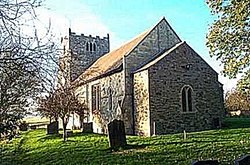Aughton, East Riding
| Aughton | |
| Yorkshire East Riding | |
|---|---|
 All Saints Church, Aughton | |
| Location | |
| Grid reference: | SE705386 |
| Location: | 53°50’21"N, -0°55’44"W |
| Data | |
| Post town: | York |
| Postcode: | YO42 |
| Dialling code: | 01757 |
| Local Government | |
| Council: | East Riding of Yorkshire |
| Parliamentary constituency: |
Haltemprice and Howden |
Aughton is a village in the East Riding of Yorkshire, standing some seven miles north-west of the local market town, Howden, and nine miles south-west of Pocklington.
It is to the west of the B1228 road and east of the River Derwent. Close by is Ellerton (with which it forms a shared civil parish, 'Ellerton and Aughton').
All Saints Church


All Saints Church, Aughton is located at the far end of the village and overlooks vast expanses of the floodplains of the River Derwent. Tucked away in the village, it can only be accessed on foot through a small gate and field adjacent to Aughton Hall.
All Saints has a long history, and it is famous, or rather infamous, for its association with Robert Aske, leader of the rebels in the Pilgrimage of Grace, raised October 1536. Aske was executed for treason on 12 July 1537.
The church displays a mixture of architectural designs as it has been altered throughout the years, but is noted especially for its Norman arch between the chancel and nave. The church is designated as a Grade I listed building.[1] On the chancel floor a well-preserved ancient brass of a knight, in 15th century plate armour, and his lady can be found, although much of the lady is now missing.
Standing in the churchyard and looking up at the tower, (which was rebuilt by Christopher Aske at some time after 1536), a shield with six quarterings can be seen engraved on the outside wall, now badly weathered but it offers the following inscription in old French text: "Christofer le second filz de Robert Ask chr oblier ne doy, Ao Di 1536.", meaning "Christopher, the second son of Robert Aske, chevalier, ought not to forget the year of our Lord 1536." Also on the tower is a benchmark of the time and carved, in sunk relief, a newt or salamander otherwise known in Middle English as an 'Ask'.
To the north of the church are the surviving earthworks, now restored, of a motte-and-bailey castle, that has been scheduled as an ancient monument.[2]
Outside links
| ("Wikimedia Commons" has material about Aughton, East Riding) |
- Images of England — details from listed building database (165263)
- Aughton in the Domesday Book
- The Aughton One-Place Study - a history of the parish
References
- ↑ National Heritage List 1346742: Church of All Saints
- ↑ National Heritage List 1007973: Motte and bailey castle, fishpond and moated site north and east of Aughton church
